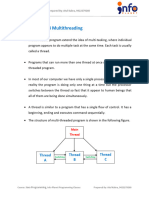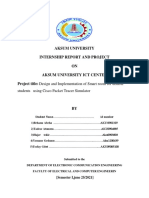0% found this document useful (0 votes)
26 views20 pagesMulti Threading
The document provides an overview of multithreading and multitasking, explaining the differences between process-based and thread-based multitasking. It details the lifecycle of threads in Java, including their states, advantages of multithreading, and synchronization methods to control access to shared resources. Additionally, it covers inter-thread communication mechanisms and examples of using threads in Java programming.
Uploaded by
Pratyush DixitCopyright
© © All Rights Reserved
We take content rights seriously. If you suspect this is your content, claim it here.
Available Formats
Download as PDF, TXT or read online on Scribd
0% found this document useful (0 votes)
26 views20 pagesMulti Threading
The document provides an overview of multithreading and multitasking, explaining the differences between process-based and thread-based multitasking. It details the lifecycle of threads in Java, including their states, advantages of multithreading, and synchronization methods to control access to shared resources. Additionally, it covers inter-thread communication mechanisms and examples of using threads in Java programming.
Uploaded by
Pratyush DixitCopyright
© © All Rights Reserved
We take content rights seriously. If you suspect this is your content, claim it here.
Available Formats
Download as PDF, TXT or read online on Scribd
/ 20






















































































